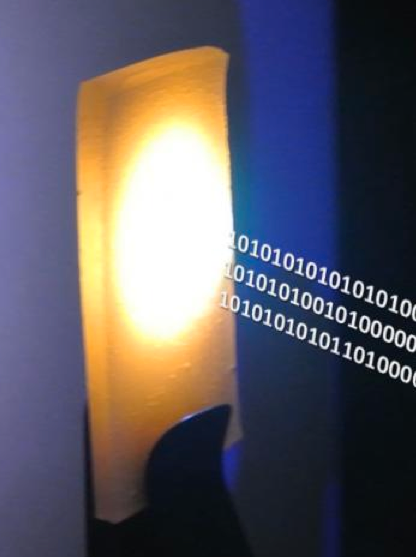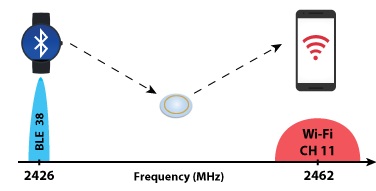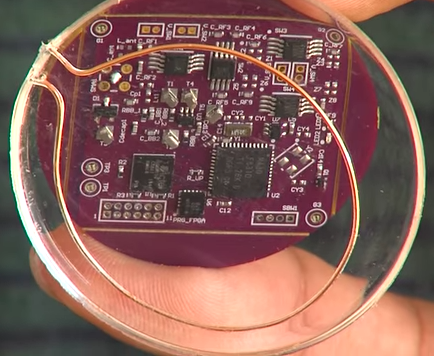Beyond Wi-Fi
August 22, 2016

A nanocrystal-based material converts blue laser emission to white light for combined illumination and high-speed data communication. (credit: KAUST 2016)
Researchers at King Abdullah University of Science and Technology (KAUST) have developed a system that uses high-speed visible light communications (VLC) to replace slower Wi-Fi and Bluetooth, allowing ceiling lights, for example, to provide an internet connection to laptops.
“VLC has many advantages compared with lower frequency communications approaches (including Wi-Fi and Bluetooth), such as energy efficiency, an unregulated communication spectrum, environmental friendliness, greater security, and no RF interferences,” according to KAUST researchers.
However, VLC is currently limited to about 100 megabits/sec. (compared to a maximum speed for the current 802.11n Wi-Fi spec of about 600 megabits/sec.) because it requires light-emitting diodes (LEDs) that produce white light, according to KAUST Professor of Electrical Engineering Boon Ooi.
These are usually fabricated by combining a diode that emits blue light with phosphorous that turns some of this radiation into red and green light. However, this conversion process limits the switching speed.
To deal with that limitation, the researchers created nanocrystals based on cesium lead bromide perovskite combined with a conventional nitride red phosphor, which achieved a data rate of 2 gigabits/sec.* That’s comparable to the newest Wi-Fi spec, 802.11ac, which can deliver about 1.7Gbps to 2.5Gbps, as Extreme Tech reports (but limited to the the 5 GHz Wi-Fi band, which has limited penetration).
Importantly, the white light generated using their perovskite nanostructures was of a quality comparable to present LED technology.
The research is presented in an open-access paper in ACS Photonics.
* When illuminated by a blue laser light, the nanocrystals emitted green light while the nitride emitted red light. Together, these combined to create a warm white light. The researchers characterized the optical properties of their material using a technique known as femtosecond transient spectroscopy. They were able to show that the optical processes in cesium lead bromide nanocrystals occur on a time scale of roughly seven nanoseconds. This meant they could modulate the optical emission at a frequency of 491 Megahertz, 40 times faster than is possible using phosphorus, and transmit data at a rate of 2 gigabits/sec.
Interscatter communication

In interscatter communication, a backscattering device such as a smart contact lens converts Bluetooth transmissions from a device such as a smartwatch to generate Wi-Fi signals that can be read by a phone or tablet. (credit: University of Washington)
University of Washington researchers have introduced another variant on Wi-Fi called “interscatter communication” that may allow devices such as brain implants, contact lenses, credit cards and smaller wearable electronics to talk to everyday devices such as smartphones and watches (to report a medical condition, for example).
The interscatter communication method works by converting Bluetooth signals into Wi-Fi transmissions. Using only reflections, an interscatter device such as a smart contact lens converts Bluetooth signals from a smartwatch, for example, into Wi-Fi transmissions that can be picked up by a smartphone.
Due to their size and location within the body, these smart contact lenses are normally too constrained by power demands to send data using conventional wireless transmissions. That means they so far have not been able to send data using Wi-Fi to smartphones and other mobile devices. Those same requirements also limit emerging technologies such as brain implants that treat Parkinson’s disease, stimulate organs and may one day even reanimate limbs.

Smart contact lens (credit: University of Washington)
The team of UW electrical engineers and computer scientists has demonstrated for the first time that these types of power-limited devices can “talk” to others using standard Wi-Fi communication. Their system requires no specialized equipment, relying solely on mobile devices commonly found with users to generate Wi-Fi signals using 10,000 times less energy than conventional methods.
“Instead of generating Wi-Fi signals on your own, our technology creates Wi-Fi by using Bluetooth transmissions from nearby mobile devices such as smartwatches,” said co-author Vamsi Talla, a recent UW doctoral graduate in electrical engineering who is now a research associate in the Department of Computer Science & Engineering.
University of Washington Computer Science & Engineering | Interscatter
Backscatter communication: piggybacking on Bluetooth
The team’s process relies on a communication technique called backscatter, which allows devices to exchange information simply by reflecting existing signals. Because the new technique enables inter-technology communication by using Bluetooth signals to create Wi-Fi transmissions, the team calls it “interscattering.”
Interscatter communication uses the Bluetooth, Wi-Fi or ZigBee radios embedded in common mobile devices like smartphones, watches, laptops, tablets and headsets, to serve as both sources and receivers for these reflected signals.
In one example the team demonstrated, a smartwatch transmits a Bluetooth signal to a smart contact lens outfitted with an antenna. To create a blank slate on which new information can be written, the UW team developed an innovative way to transform the Bluetooth transmission into a “single tone” signal that can be further manipulated and transformed. By backscattering that single tone signal, the contact lens can encode data — such as health information it may be collecting — into a standard Wi-Fi packet that can then be read by a smartphone, tablet or laptop.

Examples of interscatter communication include a) a smart contact lens using Bluetooth signals from a watch to send data to a phone b) an implantable brain interface communicating via a Bluetooth headset and smartphone and c) credit cards communicating by backscattering Bluetooth transmissions from a phone. (credit: University of Washington)
The researchers built three proof-of-concept demonstrations for previously infeasible applications, including a smart contact lens and an implantable neural recording device that can communicate directly with smartphones and watches.
Consuming only tens of microwatts
“Preserving battery life is very important in implanted medical devices, since replacing the battery in a pacemaker or brain stimulator requires surgery and puts patients at potential risk from those complications,” said co-author Joshua Smith, associate professor of electrical engineering and of computer science and engineering. “Interscatter can enable Wi-Fi for these implanted devices while consuming only tens of microwatts of power.”
Beyond implanted devices, the researchers have also shown that their technology can apply to other applications, such as smart credit cards. The team built credit card prototypes that can communicate directly with each other by reflecting Bluetooth signals coming from a smartphone.
This opens up possibilities for smart credit cards that can communicate directly with other cards and enable applications where users can split the bill by just tapping their credit cards together.
The new technique is described in an open-access paper to be presented today, Aug. 22, at the annual conference of the Association for Computing Machinery’s Special Interest Group on Data Communication (SIGCOMM 2016) in Brazil.
The research was funded by the National Science Foundation and Google Faculty Research Awards.
Abstract of Perovskite Nanocrystals as a Color Converter for Visible Light Communication
Visible light communication (VLC) is an emerging technology that uses light-emitting diodes (LEDs) or laser diodes for simultaneous illumination and data communication. This technology is envisioned to be a major part of the solution to the current bottlenecks in data and wireless communication. However, the conventional lighting phosphors that are typically integrated with LEDs have limited modulation bandwidth and thus cannot provide the bandwidth required to realize the potential of VLC. In this work, we present a promising light converter for VLC by designing solution-processed CsPbBr3 perovskite nanocrystals (NCs) with a conventional red phosphor. The fabricated CsPbBr3 NC phosphor-based white light converter exhibits an unprecedented modulation bandwidth of 491 MHz, which is ∼40 times greater than that of conventional phosphors, and the capability to transmit a high data rate of up to 2 Gbit/s. Moreover, this perovskite-enhanced white light source combines ultrafast response characteristics with a high color rendering index of 89 and a correlated color temperature of 3236 K, thereby enabling dual VLC and solid-state lighting functionalities.
Abstract of Inter-Technology Backscatter: Towards Internet Connectivity for Implanted Devices
We introduce inter-technology backscatter, a novel approach that transforms wireless transmissions from one technology to another, on the air. Specifically, we show for the first time that Bluetooth transmissions can be used to create Wi-Fi and ZigBee-compatible signals using backscatter communication. Since Bluetooth, Wi-Fi and ZigBee radios are widely available, this approach enables a backscatter design that works using only commodity devices. We build prototype backscatter hardware using an FPGA and experiment with various Wi-Fi, Bluetooth and ZigBee devices. Our experiments show we can create 2–11 Mbps Wi-Fi standards-compliant signals by backscattering Bluetooth transmissions. To show the generality of our approach, we also demonstrate generation of standards-complaint ZigBee signals by backscattering Bluetooth transmissions. Finally, we build proof-of-concepts for previously infeasible applications including the first contact lens form-factor antenna prototype and an implantable neural recording interface that communicate directly with commodity devices such as smartphones and watches, thus enabling the vision of Internet connected implanted devices.